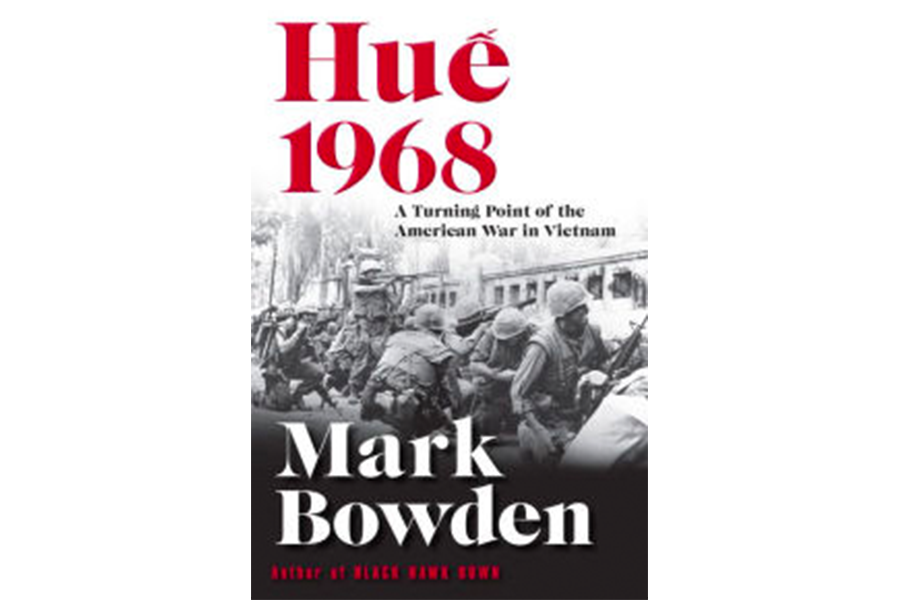'Huê 1968' is an instantly recognizable classic of military history
Loading...
A quarter of a century ago, Mark Bowden wrote his 1999 bestseller "Black Hawk Down," a gripping, terrifying account of a disastrous US military raid on Mogadishu that left 19 US soldiers dead. The book succeeded on the strength of its immediacy; in addition to pulling together as much operational detail as possible, Bowden also conducted interviews with as many participants as he could get to talk on the record.
The result was instantly hailed as a classic of modern military history, and in his latest book, Huê 1968, he replicates the methods that made "Black Hawk Down" such compelling reading: He relies on Marine and Army records from the National Archives, the corresponding documents in Vietnamese archives, the records of the National Security Council of the Lyndon Johnson administration, the papers of General Westmoreland, and the extensive oral histories of the Marine Corps, and he fleshes these sources out with interviews whose points he checks and cross-checks against the facts.
But this new book is three times the size of "Black Hawk Down" and wades into much deeper historical waters. The assault of nearly 10,000 North Vietnamese Army (NVA) and Viet Cong (VC) troops on Huê, the historical capital of Vietnam and one of the country's largest cities, that began on Jan. 31, 1968, was a key operation of the much larger Tet Offensive that had been planned in deep secrecy for months by the Communist leaders in the north for the holiday of the Lunar New Year. The Americans had been fighting in the country for years, and the Communist leaders were confident that this had bred a widespread resentment in the towns and villages – the planners of the Tet Offensive were certain that their massive military attack would be accompanied by an equally massive popular uprising to throw off the American presence.
The Americans, led by General William Westmoreland (Bowden refers to him as “Westy” throughout), were caught almost entirely by surprise, and the waves of NVA and VC forces at first scored impressive victories. In Saigon, determined (if unsuccessful) attacks were made on Presidential Palace, the Tan Son Nhut Airfield, and, infamously, the US Embassy, and Huê was the focus of viciously destructive fighting for 24 days – the bloodiest battle of the war – before VC forces were repelled with extensive loss of life and property.
Bowden tells this story with a power and a wealth of detail that no previous history of this offensive has approached – this is another instantly-recognizable classic of military history. He skillfully alternates between flashes of action – “Four hundred men rose and began running forward,” we're told. “There were too many for the enemy to shoot at once, but many were cut down as soon as they stood up. There was no choice but to keep going” – and vivid individual stories of soldiers like Private Ernie Weiss, who was caught in an explosion in the action around Huê: “The doctors there cut away his fatigues and inspected the damage,” Bowden writes. “There were nearly fifty puncture wounds up and down his left side, shrapnel but also chips of stone from the building. Most of the wounds had been cauterized, so there wasn't much bleeding.” Readers are completely immersed.
The Tet Offensive – including the prolonged fighting at Huê – has been characterized for 50 years as the psychological turning point of the Vietnam War, the watershed after which the question in the halls of power in Washington was not how to win the war but rather how to withdraw from it without further disgrace. “Tet, then, was for the Communists an unmitigated military disaster,” military historian Robert Leckie wrote in 1992. “By March, they were reeling – targets for the kill.” General Westmoreland certainly thought so: In the wake of Tet, he asked for a gigantic surge of new troops to finish off his broken opponents. “If your knowledge of the Battle of Hue came from Westy alone,” Bowden acidly writes, “from his public statements at the time and from his memoir, you would view it as a thumping American victory.” The Communist leaders had badly miscalculated; no popular uprising happened. Rather, they'd found themselves fighting desperately against rapidly-recovering US forces. In sum, Bowden writes, “Hanoi's troops seized the city and were then forced at tremendous cost to relinquish it, while the city itself was leveled in the process. The status quo was upheld but greatly diminished, and only for a few more years.”
“How is this a victory?” Bowden asks. “It makes more sense to consider the ways both sides lost.”
It's likely an eternally debatable question, and fortunately, the magnificence of "Huê 1968'" as a work of history doesn't depend on settling it. Rather, the focus here is on telling for the first time the widest possible selection of personal stories – the soldiers, the commanders, and most of all the civilians who were caught in the streets and buildings of the lovely old city as powerful forces tore it apart. Those individual stories, many of which Bowden records here for the first time, will haunt readers long after they've finished the book.






